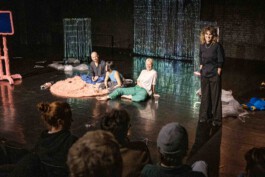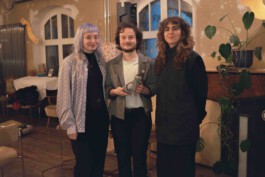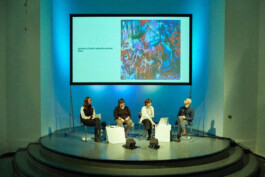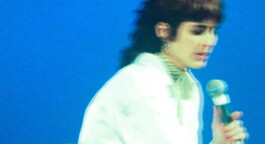In my talks, i focus on the process of artistic creation as a therapeutic, as well as emancipatory process and on the different aspects of working with art when the artist is also affected by different mental conditions. In this regard I look at the potential of artwork to be educational, transformative, to create a social discourse out of an individual expression, and to promote healing for others.

ADHS - Anders durch halbe Sachen
Audience talk 2024 at Barnes Crossing (Cologne) and ACUD Theater (Berlin)
Audience Talk for „ADHS - Anders Durch Halbe Sachen“—an interdisciplinary dance performance that expresses the inner world of a neurodivergent person.


flattern
Panel talk at Other Music Academy in Weimar 2024
Discussing barriers, chances and opportunities of neurodivergent artists in the cultural and artist work-environement.

art and survivor empowerment
Panel at the conference "Madness: Fighting for justice in Mental health System" by Disruption Network Lab in 2022 at Kunsthaus Bethanien
In order to achieve a more just and compassionate approach to mental health, it is necessary to learn to pay attention and develop a shared understanding of the individual experience of “madness”. This will consequently make it possible to develop better coping strategies for people living with mental health conditions. Artistic practices are an obvious way of making these conditions experienceable.
At the same time, artistic practices can serve as a coping strategy in themselves. They not only give survivors an opportunity to process their personal experiences, but can also be vehicles in the survivors’ fight for social justice and self-empowerment. This will be illustrated through the work of the speakers on the panel. They present three approaches to artmaking, which are different in their format, style and thematic focus, but they are all deeply insightful, subversive and transformative.


While the Conference I participated in the Sentire project. Sentire is a participatory performance project made by artists with and without schizophrenia diagnosis, that translates human interactions into sounds.

Art and De-stigmatization
Panel at "Kaleidoscope - Snapshots of a Mind" Exhibition at F94 Gallery in 2023
In this panel, guests could join the artist and curator of the exhibition as they explore the unmistakable connection between art and mental health. Professionals in their respective industries weigh in on the potential impact art has on self-expression, therapy and communication.
Trilemma of Outsider-Art
Opening speech of the "Vielfalter" project's exhibition at Kunsthaus Potsdam in 2023
"Vielfalter" creates a platform for neurodivergent artists. In April/Mai 2023 they opened an exhibition, in which only neurodivergent artists are to participate. How is such a format to be evaluated under the goal of inclusion in the arts sector? Wouldn't that categorization solidify the binary division? In this speech I used the practical-theory "Trilemma of Inclusion" (Mai-Anh Boger) and my own scientific and personal research to evaluate on this.

In my talks, i focus on the process of artistic creation as a therapeutic, as well as emancipatory process and on the different aspects of working with art when the artist is also affected by different mental conditions. In this regard I look at the potential of artwork to be educational, transformative, to create a social discourse out of an individual expression, and to promote healing for others.



ADHS - Anders durch halbe Sachen
Audience talk 2024 at Barnes Crossing (Cologne) and ACUD Theater (Berlin)
Audience Talk for „ADHS - Anders Durch Halbe Sachen“—an interdisciplinary dance performance that expresses the inner world of a neurodivergent person.
flattern
Panel talk at Other Music Academy in Weimar 2024
Discussing barriers, chances and opportunities of neurodivergent artists in the cultural and artist work-environement.


art and survivor empowerment
Panel at the conference "Madness: Fighting for justice in Mental health System" by Disruption Network Lab in 2022 at Kunsthaus Bethanien
In order to achieve a more just and compassionate approach to mental health, it is necessary to learn to pay attention and develop a shared understanding of the individual experience of “madness”. This will consequently make it possible to develop better coping strategies for people living with mental health conditions. Artistic practices are an obvious way of making these conditions experienceable.
At the same time, artistic practices can serve as a coping strategy in themselves. They not only give survivors an opportunity to process their personal experiences, but can also be vehicles in the survivors’ fight for social justice and self-empowerment. This will be illustrated through the work of the speakers on the panel. They present three approaches to artmaking, which are different in their format, style and thematic focus, but they are all deeply insightful, subversive and transformative.

While the Conference I participated in the Sentire project. Sentire is a participatory performance project made by artists with and without schizophrenia diagnosis, that translates human interactions into sounds.

Art and De-stigmatization
Panel at "Kaleidoscope - Snapshots of a Mind" Exhibition at F94 Gallery in 2023
In this panel, guests could join the artist and curator of the exhibition as they explore the unmistakable connection between art and mental health. Professionals in their respective industries weigh in on the potential impact art has on self-expression, therapy and communication.

Trilemma of Outsider-Art
Opening speech of the "Vielfalter" project's exhibition at Kunsthaus Potsdam in 2023
"Vielfalter" creates a platform for neurodivergent artists. In April/Mai 2023 they opened an exhibition, in which only neurodivergent artists are to participate. How is such a format to be evaluated under the goal of inclusion in the arts sector? Wouldn't that categorization solidify the binary division? In this speech I used the practical-theory "Trilemma of Inclusion" (Mai-Anh Boger) and my own scientific and personal research to evaluate on this.